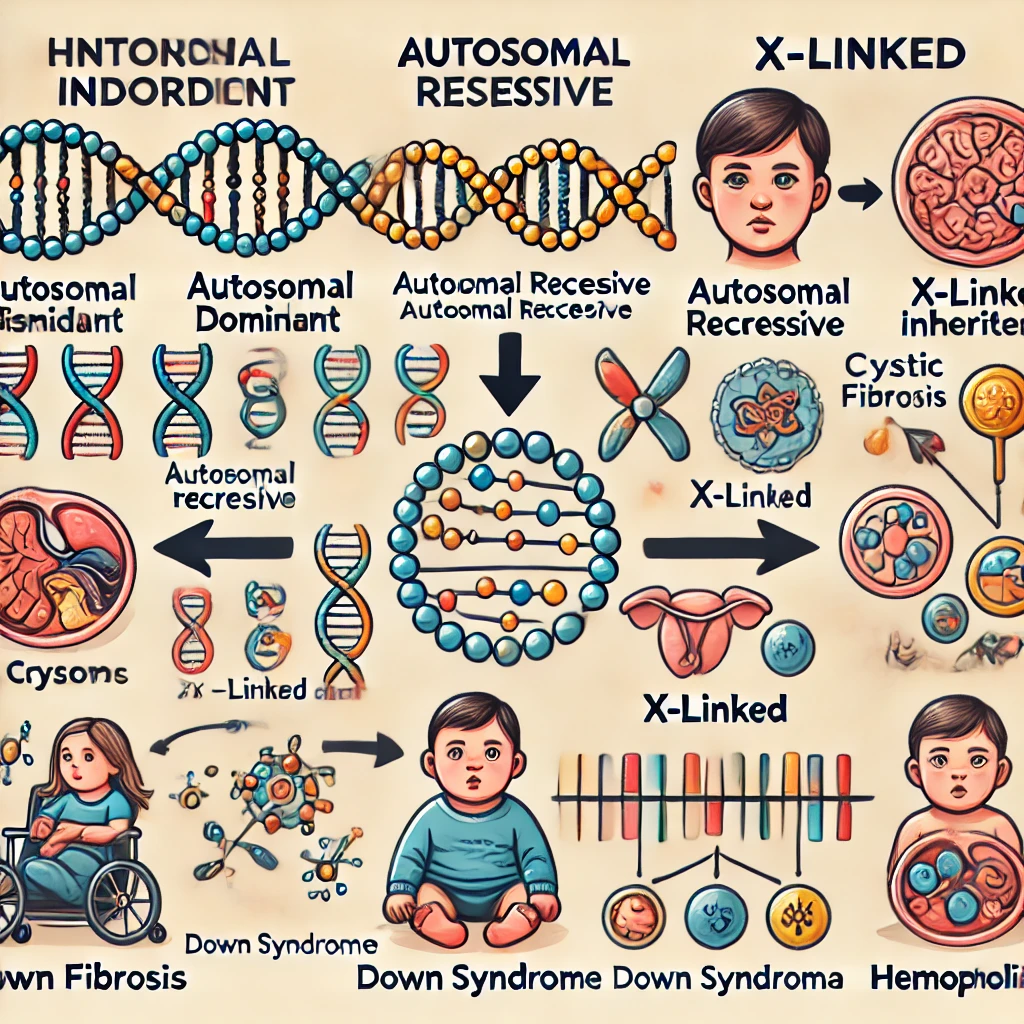Genetic Disorders: Principles of Inheritance and Variation

Genetic disorders are illnesses caused by abnormalities in the genetic material, which can be inherited or arise due to spontaneous mutations. These disorders affect individuals and can be passed down across generations. Understanding genetic disorders involves studying the principles of inheritance and variation, foundational concepts in genetics. This guide explores genetic disorders, their causes, inheritance patterns, types, and the mechanisms by which they affect individuals.
1. Basics of Inheritance and Variation
Inheritance refers to the transmission of genetic material from one generation to the next. Each individual inherits a unique combination of genes from their parents, which determines their traits. Variation, on the other hand, is the presence of differences in traits among individuals within a population. This diversity arises from genetic recombination during reproduction and from mutations. Together, inheritance and variation allow for a wide range of genetic diversity, which is essential for evolution and adaptation.
2. Genetic Disorders: Definition and Causes
Genetic disorders result from abnormalities in an individual’s DNA. These abnormalities may involve single genes, multiple genes, or entire chromosomes, leading to a wide range of disorders. Genetic disorders can be caused by:
- Mutations in Genes: Mutations, or changes in the DNA sequence, can disrupt normal gene function. These mutations may occur spontaneously or be inherited.
- Chromosomal Abnormalities: Changes in chromosome number or structure can lead to genetic disorders. For example, an extra chromosome 21 causes Down syndrome.
- Multifactorial Inheritance: Some genetic disorders are influenced by multiple genes and environmental factors, leading to complex inheritance patterns.
3. Types of Genetic Disorders
Genetic disorders can be broadly categorized into three main types:
a) Single-Gene (Mendelian) Disorders
Single-gene disorders, also called Mendelian disorders, occur due to mutations in a single gene. These disorders follow Mendelian inheritance patterns (dominant, recessive, or sex-linked). Examples include:
- Cystic Fibrosis: An autosomal recessive disorder caused by mutations in the CFTR gene, leading to thick mucus in the lungs and digestive issues.
- Sickle Cell Anemia: A mutation in the HBB gene causes red blood cells to become sickle-shaped, leading to circulation problems.
- Huntington’s Disease: An autosomal dominant disorder caused by mutations in the HTT gene, leading to progressive neurodegeneration.
b) Chromosomal Disorders
Chromosomal disorders involve abnormalities in chromosome structure or number. These disorders usually have significant effects because they can impact many genes. Examples include:
- Down Syndrome: Trisomy 21, or an extra copy of chromosome 21, causes Down syndrome, which is associated with intellectual disability and physical traits like distinct facial features.
- Turner Syndrome: Affects females who have only one X chromosome instead of two, leading to short stature, delayed puberty, and infertility.
c) Multifactorial (Complex) Disorders
Multifactorial disorders result from interactions between multiple genes and environmental factors. These conditions do not follow simple Mendelian inheritance patterns, as they are influenced by genetic predispositions and lifestyle factors. Examples include:
- Heart Disease: Linked to multiple genes affecting cholesterol levels, blood pressure, and other cardiovascular risk factors.
- Diabetes: Type 2 diabetes involves genetic factors that influence insulin regulation and lifestyle factors like diet.
- Certain Cancers: While some cancers are influenced by single-gene mutations, others result from the combined effects of genetic and environmental factors.
4. Inheritance Patterns in Genetic Disorders
The inheritance patterns of genetic disorders depend on the genes involved and the type of mutations.
a) Autosomal Dominant Inheritance
In autosomal dominant inheritance, only one mutated allele is needed for an individual to show symptoms. If one parent has the dominant allele, each child has a 50% chance of inheriting the disorder. Examples include Huntington’s disease and Marfan syndrome.
b) Autosomal Recessive Inheritance
In autosomal recessive inheritance, both alleles of a gene must be mutated for the disorder to be expressed. Carriers (individuals with one mutated allele) do not show symptoms but can pass the mutation to their offspring. If both parents are carriers, there is a 25% chance of the child inheriting the disorder. Examples include cystic fibrosis and Tay-Sachs disease.
c) X-Linked Inheritance
X-linked inheritance involves genes on the X chromosome. Because males (XY) have only one X chromosome, they are more likely to express X-linked recessive disorders than females (XX), who may be carriers without showing symptoms. Examples include hemophilia and Duchenne muscular dystrophy.
d) Mitochondrial Inheritance
Mitochondrial disorders are inherited through the mother’s mitochondria, as mitochondria are passed down only through the egg cell. Mutations in mitochondrial DNA can lead to energy production issues and affect muscles, nerves, and other high-energy-demand tissues. An example is Leber’s hereditary optic neuropathy, which causes vision loss.
5. Role of Mutations in Genetic Disorders
Mutations play a central role in genetic disorders by disrupting normal gene function. Mutations can occur in several forms:
- Point Mutations: Single nucleotide changes that may cause diseases such as sickle cell anemia.
- Frameshift Mutations: Insertions or deletions of nucleotides that disrupt the genetic code, often leading to non-functional proteins.
- Chromosomal Mutations: Large-scale changes that affect entire sections of chromosomes, resulting in conditions like Down syndrome or Cri-du-chat syndrome.
Mutations can be inherited from parents or occur spontaneously. They may arise from errors in DNA replication, exposure to environmental factors (e.g., radiation, chemicals), or due to aging.
6. Impact of Genetic Variation on Disorders
Genetic variation within populations influences the frequency and manifestation of genetic disorders. For instance, certain populations have higher frequencies of specific disorders due to genetic drift, founder effects, or environmental pressures. This variation can also impact how individuals respond to diseases or treatments.
Examples of genetic variation include:
- Sickle Cell Trait: Individuals with one mutated allele of the hemoglobin gene (sickle cell trait) are protected against malaria, demonstrating an adaptive advantage in regions where malaria is prevalent.
- Tay-Sachs Disease: More common in the Ashkenazi Jewish population due to a higher frequency of carriers.
Genetic variation is essential for evolution and survival, but it can also lead to an increased risk of specific genetic disorders within certain populations.
7. Diagnostic Approaches for Genetic Disorders
Genetic testing allows for the detection of mutations associated with genetic disorders, providing insight into an individual’s risk factors and potential for passing mutations to offspring. Types of genetic tests include:
- Carrier Screening: Identifies carriers of specific genetic disorders, especially valuable for autosomal recessive disorders.
- Prenatal Testing: Screens for genetic abnormalities in a developing fetus, including conditions like Down syndrome.
- Newborn Screening: Identifies genetic conditions early in life, allowing for prompt intervention in conditions like phenylketonuria (PKU).
- Preimplantation Genetic Diagnosis (PGD): Tests embryos for genetic abnormalities before implantation during in vitro fertilization (IVF).
Genetic counseling is an essential part of genetic testing, providing families with information on inheritance patterns, the risks of passing on genetic disorders, and the implications of test results.
8. Advances in Treatment and Gene Therapy
Advances in genetics have led to new treatment options for genetic disorders, including gene therapy. Gene therapy involves inserting, removing, or altering DNA within a patient’s cells to treat disease. Key approaches in gene therapy include:
- Gene Replacement Therapy: Replaces a mutated gene with a healthy copy to restore normal function.
- Gene Editing (CRISPR): Uses precision tools to directly edit the DNA, allowing scientists to correct mutations at their source.
- RNA Therapy: Modifies RNA to prevent the expression of faulty genes or encourage the production of functional proteins.
While gene therapy holds promise, it is still largely experimental for many disorders, and challenges such as immune reactions and delivery to target cells remain.
9. Ethical Considerations in Genetic Research and Testing
Genetic testing and therapies raise ethical questions about privacy, discrimination, and the implications of altering genes. For instance, genetic information could potentially be misused by employers or insurers, leading to genetic discrimination. Additionally, genetic testing in fetuses raises questions about reproductive decisions and the ethical implications of selecting embryos free from specific genetic traits.
Gene editing, particularly germ-line editing (which would affect future generations), poses concerns about unintended consequences, the potential for “designer babies,” and the ethical limits of altering human genetics. Establishing guidelines and policies is essential to ensure responsible use of genetic technologies.
10. Case Studies of Genetic Disorders
a) Sickle Cell Anemia
Sickle cell anemia is an autosomal recessive disorder caused by a point mutation in the HBB gene, leading to abnormal hemoglobin. This disorder exemplifies how a single mutation can have widespread physiological effects, impacting blood flow and oxygen delivery.
b) Cystic Fibrosis
Caused by mutations in the CFTR gene, cystic fibrosis affects mucus production in the lungs and digestive system. Advances in gene therapy are being explored to correct or replace the faulty gene, showcasing how genetic understanding can lead to targeted treatments.
c) Down Syndrome
Down syndrome results from an extra chromosome 21. It demonstrates the impact of chromosomal abnormalities and the importance of prenatal testing in identifying such disorders early on.
1. What are genetic disorders, and how are they classified?
- Answer: Genetic disorders are diseases caused by abnormalities in an individual’s DNA. These abnormalities may involve single-gene mutations, multiple genes, or entire chromosomes. Genetic disorders are typically classified into three main types:
- Single-Gene (Mendelian) Disorders: Caused by mutations in a single gene, following Mendelian inheritance patterns (e.g., cystic fibrosis).
- Chromosomal Disorders: Result from structural changes in chromosomes, such as extra or missing chromosomes (e.g., Down syndrome).
- Multifactorial Disorders: Caused by a combination of genetic and environmental factors, with complex inheritance patterns (e.g., heart disease, diabetes).
2. What is Mendelian inheritance, and how does it relate to genetic disorders?
- Answer: Mendelian inheritance refers to the genetic principles proposed by Gregor Mendel, which describe how traits are inherited through dominant and recessive alleles. In the context of genetic disorders:
- Autosomal Dominant Disorders require only one mutated allele to cause disease (e.g., Huntington’s disease).
- Autosomal Recessive Disorders require both alleles to be mutated for the disease to manifest (e.g., sickle cell anemia).
- X-Linked Disorders involve genes on the X chromosome, affecting males more severely as they have only one X chromosome (e.g., hemophilia).
3. What causes chromosomal disorders, and can you give examples?
- Answer: Chromosomal disorders arise from abnormalities in chromosome structure or number, often due to errors in cell division. Common types include:
- Down Syndrome: Caused by an extra copy of chromosome 21 (trisomy 21).
- Turner Syndrome: Occurs in females with only one X chromosome, leading to developmental delays and infertility.
- Klinefelter Syndrome: Involves an extra X chromosome in males (XXY), affecting physical and reproductive development.
4. How does autosomal recessive inheritance work in genetic disorders?
- Answer: In autosomal recessive inheritance, both parents must carry one copy of a mutated gene for the child to inherit the disorder. If both parents are carriers:
- There is a 25% chance the child will inherit two mutated alleles and have the disorder.
- A 50% chance the child will inherit one mutated allele and be a carrier.
- A 25% chance the child will inherit two normal alleles.
- Examples: Cystic fibrosis and Tay-Sachs disease follow autosomal recessive inheritance patterns.
5. What is the difference between a mutation and a variation in genetics?
- Answer: A mutation is a change in the DNA sequence that may cause a gene to function differently or lead to disease. A variation, however, is a normal difference in DNA that may or may not affect health, contributing to diversity within a population. Variations can provide evolutionary benefits, while mutations often disrupt normal biological functions.
6. Why are males more frequently affected by X-linked recessive disorders?
- Answer: X-linked recessive disorders occur when there is a mutation in a gene on the X chromosome. Males have only one X chromosome (XY), so if they inherit a mutated X-linked gene, they will express the disorder because they lack a second X chromosome to offset the mutation. Females, with two X chromosomes, can often carry the mutation without showing symptoms due to their second, healthy X chromosome. Examples include hemophilia and Duchenne muscular dystrophy.
7. What are some methods for diagnosing genetic disorders?
- Answer: Genetic disorders are diagnosed using several techniques, including:
- Carrier Screening: Identifies individuals carrying mutated genes, especially important for recessive disorders.
- Prenatal Testing: Screens for genetic abnormalities in a developing fetus (e.g., amniocentesis).
- Newborn Screening: Detects genetic disorders early in life for prompt treatment (e.g., phenylketonuria testing).
- Genetic Counseling: Provides information on inheritance risks and genetic testing options for families.
8. What is multifactorial inheritance, and how does it relate to genetic disorders?
- Answer: Multifactorial inheritance refers to disorders influenced by multiple genes and environmental factors. These conditions are complex because they do not follow a single inheritance pattern and can vary significantly in severity. Multifactorial disorders include common diseases like heart disease, diabetes, and some cancers, which are impacted by lifestyle factors like diet, exercise, and smoking.
9. How does mitochondrial inheritance differ from other inheritance patterns?
- Answer: Mitochondrial inheritance is unique because mitochondria (and their DNA) are passed exclusively from mother to child, as sperm typically do not contribute mitochondria during fertilization. Disorders resulting from mutations in mitochondrial DNA affect high-energy-demand tissues (e.g., muscles, brain). An example is Leber’s hereditary optic neuropathy, a condition causing vision loss.
10. What are some ethical concerns related to genetic testing and gene therapy?
- Answer: Ethical concerns around genetic testing and therapy include:
- Privacy and Discrimination: Genetic information could be misused by insurers or employers.
- Reproductive Decisions: Prenatal genetic testing raises questions about making decisions based on genetic traits.
- Germline Editing: Editing genes in germ cells (sperm or eggs) affects future generations, raising concerns about unintended consequences and “designer babies.”
- Informed Consent: Ensuring individuals fully understand the implications of testing and therapy is essential, especially as technology advances.






